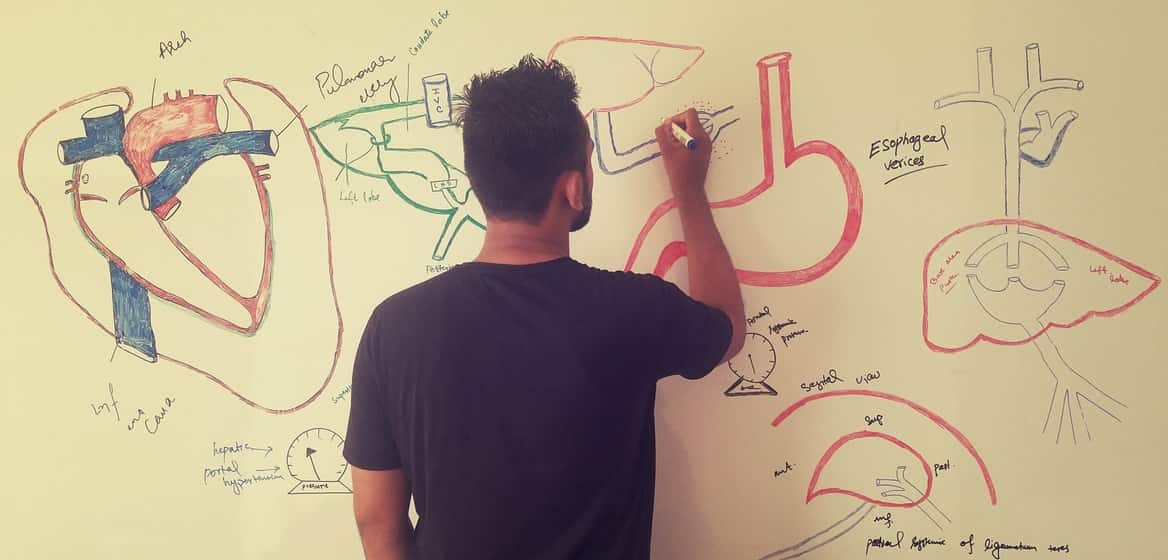Cardiac Cycle
Cardiac cycle often refers to the alternating contraction and relaxation of the myocardium in the walls of the heart chambers coordinated by the conducting system during one heartbeat. The frequency of the cardiac cycle is described by the heart rate. The cycle is divided into two major phases therefore
- Systole
- Diastole
Systole: The period of ventricular contraction therefore
Diastole: The period of ventricular relaxation therefore
- During diastole, there is the relaxation of cardiac muscle and filling of blood.
- Various changes occur in different chambers of the heart during each heartbeat.
- These changes are repeated during every heartbeat in a cyclic manner. therefore
Learn why 1 million+ medical students and doctors have joined MadeForMedical to master medical sciences.

Click Here: https://www.madeformedical.com/master-bascis-mfm
Divisions of Cardiac Cycle
The contraction and relaxation of atria are called atrial systole and atrial diastole respectively. The contraction and relaxation of the ventricles are called ventricular systole and ventricular diastole respectively. It is named after Dr. Carl J. Wiggers, M.D.
The three basic events are
- Left ventricular contraction therefore
- LV relaxation therefore
- Left ventricular filling therefore
Left Ventricular Contraction
LV pressure starts to build up when the arrival of calcium ions at the contractile proteins starts to trigger actin-myosin interaction. On the electrocardiogram (ECG), the advance of the wave of depolarization is indicated by the peak of the R wave. Soon after, LV pressure in the early contraction phase builds up and exceeds that in the left atrium. (normally, 10 to 15 mm Hg). Followed about 20 milliseconds later by M1, the mitral component of the first heart sound. therefore
Mitral valve closure is often thought to coincide with the crossover point at which the LV pressure starts to exceed the left atrial pressure. In reality, mitral valve closure is delayed because the valve is kept open by the inertia of the blood flow. Shortly thereafter, pressure changes in the right ventricle, similar in pattern but lesser in magnitude to those in the left ventricle, causing the tricuspid valve to close.there by creating T1, the second component of the first heart sound. therefore
During this phase
of contraction between the mitral valve and the aortic valve opening, the LV volume is fixed (isovolumic contraction) because aortic and mitral valves are shut.• As more and more myofibers enter the contracted state, pressure development in the left ventricle proceeds. The interaction of actin and myosin increases and cross-bridge cycling rises. therefore
When the pressure in the left ventricle exceeds that in the aorta, the aortic valve opens, usually a clinically silent event. The opening of the aortic valve is followed by the phase of rapid ejection. The rate of ejection is determined not only by the pressure gradient across the aortic valve but also by the elastic properties of the aorta and the arterial tree, which undergoes systolic expansion. LV pressure rises to a peak and then starts to rise. therefore
Myocardial dysfunction prolongs PEP and shortens LVET.• These intervals are also influenced by many hemodynamic and electrical variables.• Weissler et al. derived an index (PEP/LVET) called “systolic time interval“.• This is less heart rate dependent as a measure of LV systolic function. therefore
Learn why 1 million+ medical students and doctors have joined MadeForMedical to master medical sciences.

Click Here: https://www.madeformedical.com/master-bascis-mfm
Left Ventricular Relaxation
As the cytosolic calcium ion concentration starts to decline because of uptake of calcium into the SR under the influence of activated phospholamban, more and more myofibers enter the state of relaxation and the rate of ejection of blood from the left ventricle into the aorta falls. ( phase of reduced ejection). During this phase, blood flow from the left ventricle to the aorta rapidly diminishes but is maintained by aortic recoil – the Windkessel effect. therefore because
The pressure in the aorta exceeds the falling pressure in the left ventricle. The aortic valve closes, creating the first component of the second sound, A2 (the second component, P2, results from closure of the pulmonary valve as the pulmonary artery pressure exceeds that in the right ventricle). Thereafter, the ventricle continues to relax. Because the mitral valve is closed during this phase, the volume cannot change (isovolumic relaxation). therefore because
isovolumic relaxation time (IVRT) is also affected by LV function. Mancini et incorporated IVRT into an index called the “isovolumic index” derived as (IVCT + IVRT)/LVET. The sum of IVCT and IVRT was measured by subtracting the LVET from the peak of the R wave on the electrocardiogram to the onset of mitral valve opening. therefore
Left Ventricular Filling Phase
As LV pressure drops below that in the left atrium, just after mitral valve opening, the phase of rapid or early filling occurs, which accounts for most of the ventricular filling. Active diastolic relaxation of the ventricle may also contribute to early filling ( “Ventricular Suction During Diastole”). Such rapid filling may cause the physiological third heart sound (S3), particularly when there is a hyperkinetic circulation. As pressures in the atrium and ventricle equalize, LV filling virtually stops (diastasis). This is achieved by atrial systole (or the left atrial booster), which is especially important when a high cardiac output is required, as during exercise, or when the LV fails to relax normally, as in left ventricular hypertrophy. therefore because
Learn why 1 million+ medical students and doctors have joined MadeForMedical to master medical sciences.

Click Here: https://www.madeformedical.com/master-bascis-mfmcardiac

Thank you
I have learnt enough willing to learn more and more
I found a lot of these ideas and suggestion very well thought out I also found this care plan suggestions…
I have learn a lot, thank so much to share such a good NCP.
Very good. I thanks my teacher